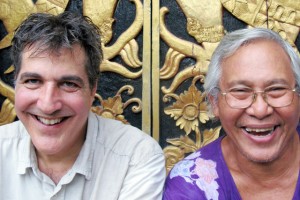5 Questions With . . . Professor of Theater Ron Jenkins

This issue, we ask “5 Questions” to Ron Jenkins, professor of theater. Jenkins is an expert in Balinese theater, international traditions of comic performance, and directing and translating the plays of Italian Nobel Laureate Dario Fo. He was awarded a residency at the Bellagio Center by the Rockefeller Foundation next spring. He is a former Guggenheim fellow whose research in Bali over the past 30 years has been supported by fellowships from the Watson Foundation, the Asian Cultural Council of the Rockefeller Brothers Fund and the Fulbright Fund.
Q: Professor Jenkins, you’ve been teaching theater at Wesleyan for 11 years, specializing in international theater translation and prison arts programs. You directed the student/inmate play, “Unexpected: Voices of Incarcerated Woman” last spring. How, and when, did you acquire these interests?
A: I began my professional theater career as a clown and juggler in the circus, where I enjoyed having direct contact with large and diverse audiences, but I had to spend time in other cultures to discover clown and theater traditions with a deeper sense of social responsibility. I lived for a year in a Balinese village where I apprenticed with a troupe of temple performers who combined slapstick, political satire, and references to sacred texts. Later I spent a year touring Italy with Dario Fo, a great performer of physical comedy who eventually became the first clown to win the Nobel Prize in Literature. Since then I’ve devoted a lot of time to translating, teaching, directing, and to writing about the plays of Fo and the Balinese theater traditions. Immersing myself in international theater with a social conscience inspired me to pursue theater in America that contributed to civic awareness, so I naturally gravitated towards the dramatization of voices that are often ignored, like the incarcerated women that my students have worked with over the past few years.
Q: Your visually-stunning 330-page book, Rua Bineda in Bali: Counterfeit Justice in the Trial of Nyoman Gunarsa, is hot off the presses of the Indonesian University of the Arts. The book (featured in the video clip below) focuses on how a Balinese painter, puppet-master and a Brahmin priest perceive a landmark court case involving art forgery and identity theft. Who is Nyoman Gunarsa, and what was your fascination with his case?
A: Nyoman Gunarsa is an acclaimed Balinese painter whose paintings were forged and sold without his knowledge. When the Indonesian justice system failed to enforce existing copyright laws or punish the perpetrators, the case was taken up by anti-corruption groups as an example of how vulnerable the justice system was to bribery and graft. What interested me was how quickly the artists of Bali responded to the injustice of the situation, so I wrote the book as a case study of the ways in which art and social issues are integrated in Balinese culture. Before the trial had ended, thousands of people gathered in the capitol city’s main square to watch a shadow puppet play that made the complex issues of the case accessible to ordinary people by re-imagining the forgery as a scene from the Hindu epic Ramayana with characters that are familiar to everyone in Bali. When the court system could not provide justice, people looked for justice in the realms of theater, poetry and painting.
Q: What was involved in your research?
A: I spent two years working on the book. The research began during my sabbatical in Indonesia which was sponsored by a Fulbright Research Grant that gave me the opportunity to go the courtroom every day of the trial, and to interview the shadow puppet master, painter and Hindu high priest whose artistic responses to the trial are documented in the text.
Q: You were recently featured in The Jakarta Post, where your book was described as “beautiful, interesting, truly multi-cultural, original” and “definitely not your ordinary coffee table book.” Who is the audience of this book? Also, when will the book be released in the United States?
A: I designed the book to be entertaining and informative to anyone interested in the arts and their social value. It is lavishly illustrated with paintings of Hindu mythological heroes, photographs of shadow puppets and Balinese calligraphy. The text of the puppet play is peppered with jokes and off-color puns. And the trial transcripts are full of surprising drama, including a great moment when the painter breaks out into a Balinese dance to prove to the judge that the forged artwork could never have been painted by him. The University of Hawaii Press agreed to distribute the book after seeing the galley proofs and will put it in their catalogue as soon as they process the Indonesian paperwork.
Q: You have a doctorate in education and theater from Harvard University and a Master of Buffoonery from the Ringling Brothers College for Clowns. How do you use humor in your teaching/directing/research/writing/plays/working with students?
A: I think the circus is wonderful preparation for academia. Once you have had the experience of letting your trousers fall down in a circus ring while thousands of people laugh at your underwear, it is impossible ever to take yourself too seriously, no matter how many degrees you may subsequently acquire.

